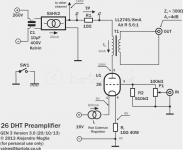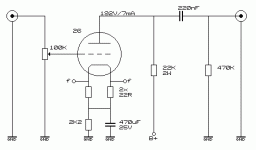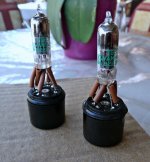The 46 has a mu of 5.6.
The 2A3 needs 45Vp to drive it.
Therefore you need either 8Vp at the input, or a step up inter-stage transformer to reduce the input requirement.
If you parallel the primaries of the LL2753, and series the secondary you will have a 1:2 ratio, and an input requirement of 4Vp, but may lose primary inductance and LF response.
4Vp is 2.8Vrms
Neither grid will be negative as shown in the schematic. It would be more correct to denote the positive voltage at the filaments and the grids at ground potential.
The 2A3 needs 45Vp to drive it.
Therefore you need either 8Vp at the input, or a step up inter-stage transformer to reduce the input requirement.
If you parallel the primaries of the LL2753, and series the secondary you will have a 1:2 ratio, and an input requirement of 4Vp, but may lose primary inductance and LF response.
4Vp is 2.8Vrms
Neither grid will be negative as shown in the schematic. It would be more correct to denote the positive voltage at the filaments and the grids at ground potential.
See what I had written before (see # 4704):
"As for the control of 2A3 (voltage oscillation), with a polarization of -45 V, complete control in class A1 (negative voltage on the grid) is required, Vpp = 2x45 V, or 90 Vpp, or 90 x 0, 3535 = 31.8 V RMS. That's all 46 needs to give.
Tube 46 is polarized -33 V on the grid, i.e. maximum voltage swing = 2x33 V = 66 Vpp, or 66 Vpp x 0.3535 = 23.3 V RMS. This must be multiplied by the gain of the tube, i.e. approximately 5.6x, so we have 368 Vpp = 130.4 V RMS. So we have a great offer and tube 46 is suitable for this role. (N.B.: 130.4 V RMS: 0.3535 = 368 Vpp)"
The first part seems right.
Where did I calculate wrong ???
"As for the control of 2A3 (voltage oscillation), with a polarization of -45 V, complete control in class A1 (negative voltage on the grid) is required, Vpp = 2x45 V, or 90 Vpp, or 90 x 0, 3535 = 31.8 V RMS. That's all 46 needs to give.
Tube 46 is polarized -33 V on the grid, i.e. maximum voltage swing = 2x33 V = 66 Vpp, or 66 Vpp x 0.3535 = 23.3 V RMS. This must be multiplied by the gain of the tube, i.e. approximately 5.6x, so we have 368 Vpp = 130.4 V RMS. So we have a great offer and tube 46 is suitable for this role. (N.B.: 130.4 V RMS: 0.3535 = 368 Vpp)"
The first part seems right.
Where did I calculate wrong ???
Tube 46 is polarized -33 V on the grid, i.e. maximum voltage swing = 2x33 V = 66 Vpp, or 66 Vpp x 0.3535 = 23.3 V RMS. This must be multiplied by the gain of the tube, i.e. approximately 5.6x, so we have 368 Vpp = 130.4 V RMS. So we have a great offer and tube 46 is suitable for this role. (N.B.: 130.4 V RMS: 0.3535 = 368 Vpp)"
The first part seems right.
Where did I calculate wrong ???
??
Your calculation merely shows that a 46 is very able to drive a 2A3.
2A3 needs 31.8 VRMS at it's grid for full power A1.
46 has gain of 5.6.
So 46 needs 31.8/5.6 = 5.7 VRMS at it's grid to drive 2A3.
With for example 2 VRMS of some digital source and a 1:3 input transformer you "might" get there, but another input tube for voltage gain is probably the better approach.
Now the picture of the situation is clearer to me.
I apologize for my reasoning, which is not my sack flour. I didn't study electronics and I took the reasoning literally from the development of another project, where it seemed to me that the designer knew what he was doing.
I'm just - laboriously - learning the basic rules.
Thanks everyone for the explanations.
I apologize for my reasoning, which is not my sack flour. I didn't study electronics and I took the reasoning literally from the development of another project, where it seemed to me that the designer knew what he was doing.
I'm just - laboriously - learning the basic rules.
Thanks everyone for the explanations.
??
Your calculation merely shows that a 46 is very able to drive a 2A3.
2A3 needs 31.8 VRMS at it's grid for full power A1.
46 has gain of 5.6.
So 46 needs 31.8/5.6 = 5.7 VRMS at it's grid to drive 2A3.
With for example 2 VRMS of some digital source and a 1:3 input transformer you "might" get there, but another input tube for voltage gain is probably the better approach.
Your calculations are correct - can't imagine wh<y I forgot the factor 2...
But when you use a 3rd stage then I'd recommend to think over for using 2 stages and an IDHT for the first / driver stage because it produces lower distortion
I will only build a 3-stage amplifier when I hear one that sounds better than a 2-stage one.
Two stages from 2vRMS input to driving loudspeaker via output transformer?
HK
My amp is 2 stage - 26 driving PSE 4P1L. The beauty of the 4P1L is that it's easy to drive, has a mu of 11 and can be used in filament bias without needing a cathode bypass cap. I have 2v in from my DAC and that's enough for my smallish room. All my sources are on my Mac Pro - music, Internet and TV - so I get the best sound possible all day. I'm well satisfied. Volume is just enough, and volume control is in software. A DAC and 2 DHT stages are all I have and need. My sound system is on 24/7 but I have a large drawer full of 4P1L I bought cheap, so I'm not worried.
Last edited:
Hi Andy,
Great to hear from you. I hope you’re keeping well and safe in these uncertain times.
I’ve not had time to follow up as much as I wanted on the blog am afraid. Good to hear you’re sticking to the 26-4P1L. It’s a great combination.
I still play with 01a (with SiC filament bias) into 801a preamp as need the gain due to my low voltage source. I’ve been testing some options with Aa and Ba triodes as the extra gain is good in my system. And love all these combinations, however I still go back to the 01a which somehow prefer over the rest.
Lately I built a new Mule with the RE084, I used it years ago and brought it back again. Again, another great DHT. Have an RE034 around with a tad more gain but they need source follower stage in between due to low anode current.
I’ll play a bit more around with some other DHTs, time permitting. My young children are at home 24x7 which proves to be more challenging for us than we thought and leaves me no time to work on audio pretty much. We’ll see when we get into a routine hopefully.
Cheers
Ale
Great to hear from you. I hope you’re keeping well and safe in these uncertain times.
I’ve not had time to follow up as much as I wanted on the blog am afraid. Good to hear you’re sticking to the 26-4P1L. It’s a great combination.
I still play with 01a (with SiC filament bias) into 801a preamp as need the gain due to my low voltage source. I’ve been testing some options with Aa and Ba triodes as the extra gain is good in my system. And love all these combinations, however I still go back to the 01a which somehow prefer over the rest.
Lately I built a new Mule with the RE084, I used it years ago and brought it back again. Again, another great DHT. Have an RE034 around with a tad more gain but they need source follower stage in between due to low anode current.
I’ll play a bit more around with some other DHTs, time permitting. My young children are at home 24x7 which proves to be more challenging for us than we thought and leaves me no time to work on audio pretty much. We’ll see when we get into a routine hopefully.
Cheers
Ale
Great to hear from you, Ale. I've stuck with the 26 because I like the sound in SIC bias - very grateful to you for turning me on to that. I run it at 7mA - it would be nice to have a bit more current but it seems to cope as a driver for the PSE 4P1Ls. I really have no desire to explore anything else, though as an experiment I'm building a 300b amp with 2 stages, where I'll use a driver with higher mu, probably one of the Russian pentodes you've been trying out in triode mode.
I've been doing quite a lot of songwriting recently since I have time on my hands, and this has taken me back to stage gear. I built a tube microphone and I'm currently building/modifying my bass guitars. So back to tone woods after almost exclusively doing metalwork. Next step is a tube amp for the bass like our friend Paul Leclercq is so into building. I know you play as well, and maybe stage gear will lure you next. You would have so much to offer the tube microphone and tube amp scene and you could really shake up the rather formulaic circuits being used. Like why are we using SIC bias/filement bias and gyrators/plate chokes for hi-fi amps and not for stage amps and microphones?
I've been doing quite a lot of songwriting recently since I have time on my hands, and this has taken me back to stage gear. I built a tube microphone and I'm currently building/modifying my bass guitars. So back to tone woods after almost exclusively doing metalwork. Next step is a tube amp for the bass like our friend Paul Leclercq is so into building. I know you play as well, and maybe stage gear will lure you next. You would have so much to offer the tube microphone and tube amp scene and you could really shake up the rather formulaic circuits being used. Like why are we using SIC bias/filement bias and gyrators/plate chokes for hi-fi amps and not for stage amps and microphones?
You're all wrong guys...
90 Vpk-pk is 31,8 VRMS (divide pk-pk voltage by 2,83....).
This is basic stuff....
Is divide by Squar root of 2, in this case single ended is 1.41
2.83 is for pushpull
Regards
Hi Everyone,
I feel badly posting such a beginner question here.
But here goes:
I'm building a 26 preamp based on Ale Moglia's Gen3 schematic (see below, I hope Ale doesn't mind me posting it here.) I have a bit of a wait on the LL2745 as they are out of stock.
I would like to get the rest up and running, and wondered if I could simply replace the output transformer with an RC network for the time being?
Something like 22k plate load and .22uF to output?
Thanks in advance for your advice!
Best,
John

I feel badly posting such a beginner question here.
But here goes:
I'm building a 26 preamp based on Ale Moglia's Gen3 schematic (see below, I hope Ale doesn't mind me posting it here.) I have a bit of a wait on the LL2745 as they are out of stock.
I would like to get the rest up and running, and wondered if I could simply replace the output transformer with an RC network for the time being?
Something like 22k plate load and .22uF to output?
Thanks in advance for your advice!
Best,
John

A resistor as anode-load is difficult with the 26. The Value of the resistor would need to be high, to maintain the performance of the 26 DHT - 22KΩ, say.
This value is too high to drive cables, or external loads.
If the trafo is out-of-stock, you could try the 'gyrator' anode/plate load. There is a very well-implemented version on Ale's (Bartola Valves) site. This presents a high-impedance load to the 26, while offering a low-impedance output drive. This is a much better solution....
This value is too high to drive cables, or external loads.
If the trafo is out-of-stock, you could try the 'gyrator' anode/plate load. There is a very well-implemented version on Ale's (Bartola Valves) site. This presents a high-impedance load to the 26, while offering a low-impedance output drive. This is a much better solution....
Hi,
Thanks for your replies!
Doing a Gyrator is a good idea, but would mean another parts order and more waiting time--especially if I use Ale's boards as shipping to the US would likely take a while. (I just put in a request for a pair of Gyrator PCBs. It would be nice to try them at some point.)
I was really thinking of something I could implement today. Just for "shelter-in-place" entertainment. I have 22k 2w resistors and a couple 220nF caps.
It was Jim De Kort's RC coupled 26 preamp that got me wondering (see attached schematic).
He only used this during experimental stages and later went to a choke loaded design. But he did say it worked, and sounded good enough to make him pursue further.

Thanks for your replies!
Doing a Gyrator is a good idea, but would mean another parts order and more waiting time--especially if I use Ale's boards as shipping to the US would likely take a while. (I just put in a request for a pair of Gyrator PCBs. It would be nice to try them at some point.)
I was really thinking of something I could implement today. Just for "shelter-in-place" entertainment. I have 22k 2w resistors and a couple 220nF caps.
It was Jim De Kort's RC coupled 26 preamp that got me wondering (see attached schematic).
He only used this during experimental stages and later went to a choke loaded design. But he did say it worked, and sounded good enough to make him pursue further.

My amp is 2 stage - 26 driving PSE 4P1L. The beauty of the 4P1L is that it's easy to drive, has a mu of 11 and can be used in filament bias without needing a cathode bypass cap. I have 2v in from my DAC and that's enough for my smallish room. All my sources are on my Mac Pro - music, Internet and TV - so I get the best sound possible all day. I'm well satisfied. Volume is just enough, and volume control is in software. A DAC and 2 DHT stages are all I have and need. My sound system is on 24/7 but I have a large drawer full of 4P1L I bought cheap, so I'm not worried.
hi andy , do you have a schematic of your last SET , when all this crap will be over i plan to build a 26 PX4 amp
- Home
- Amplifiers
- Tubes / Valves
- #26 pre amp
